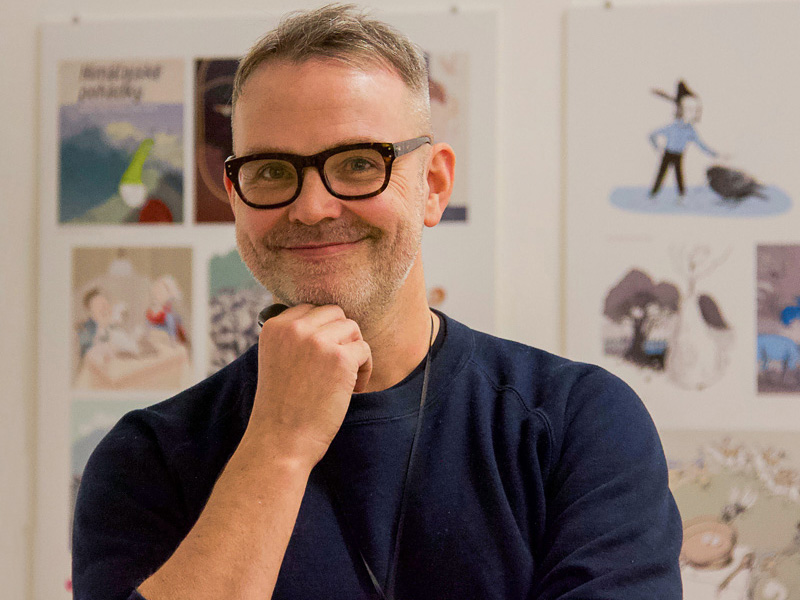
The British illustrator Rob Biddulph, author of picture books Odd Dog Out, Blown Away, Sunk!, and Kevin, was a guest at Moscow’s 2018 Non/Fiction book fair. In an interview with Papmambook’s Darya Dotsuk, he told our readers why he prefers to write in rhyme, the books he reads his daughters before bed, and how ideas for his plots and characters are born.
- Rob, tell us the story of how your first picture book came to be.
- The idea of creating a picture book came to me rather later in life. Every evening I enjoyed reading to my daughters before bed and on one such occasion it occurred to me that it would be great to write my own book. The first book I came up with was Kevin Most recent English edition: HarperCollins, 2018. ISBN 9780008207427. . That was ten years ago. The first version of the book was quite different from the one you see today. I sent it out to literary agents and they sent it to publishers. Everyone seemed to like it, discussions went on, I continued incorporating suggested edits, but it never got any closer to being published.
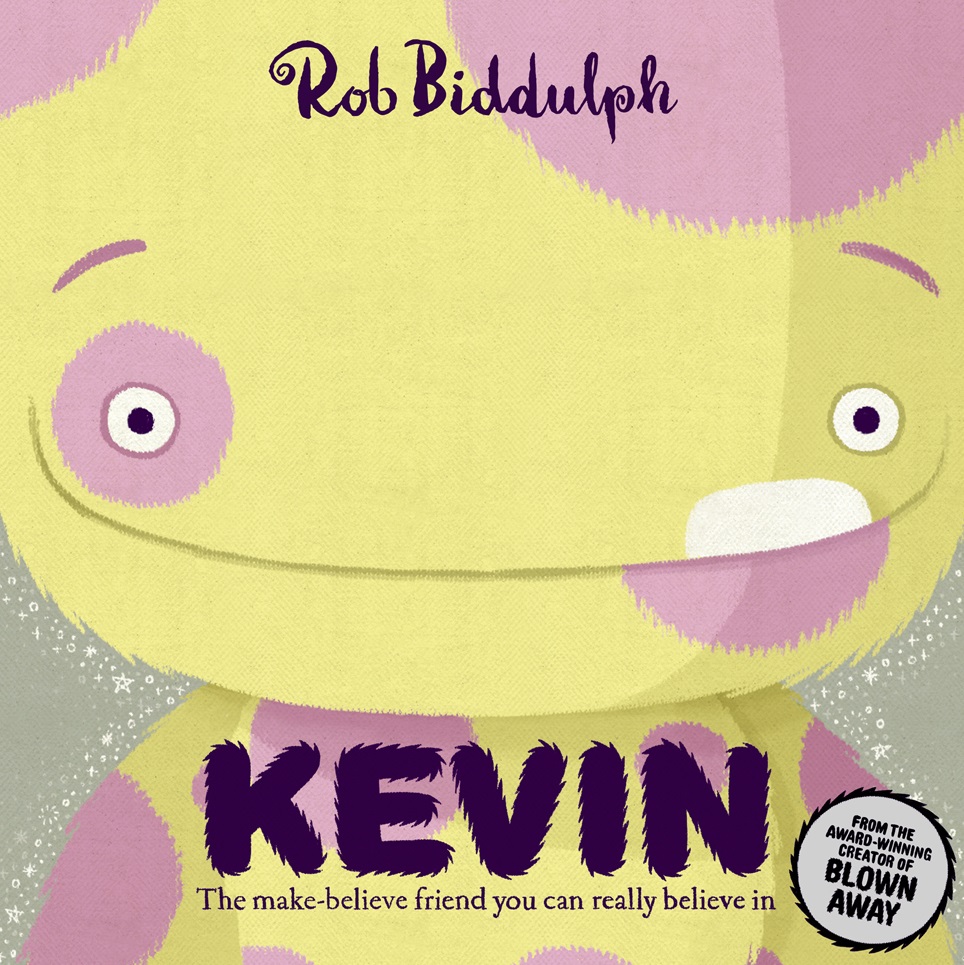
Image: robbiddulph.com
This went on for years until my agent suggested that I put together a portfolio for publishers. “Draw some pirates, dinosaurs, children, and animals.” So I did. There was a little penguin in the drawings that the publishers noticed right away and they asked me to write a book about him. In my drafts, I had a story about children who get carried away by a kite, so I thought, “What if the main character was a penguin instead of a little boy?” Even though a penguin is a bird, it can’t fly, so the kite was a way he could take flight.
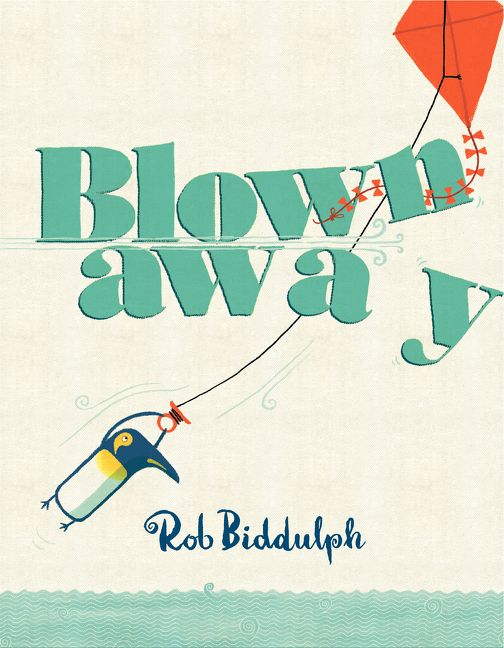
Image: harpercollins.com
Blown Away Most recent English edition: HarperCollins, 2017. ISBN 9780008166670. came out and won the Children’s Book Prize from Waterstones book retailer. There’s a Waterstones in almost every British town and, believe it or not, for about a month, Blown Away was as popular as Harry Potter. For a first-time author this is something unimaginable—people know your name and are asking about the next book. I got very lucky. All thanks to a little penguin!
- And you decided to write another book about Penguin Blue. And so there was Sunk! Most recent English edition: HarperCollins, 2017. ISBN 9780008207403. .
- Yes, it was great to revisit the characters I had made such good friends with. I thought readers would enjoy it as well.
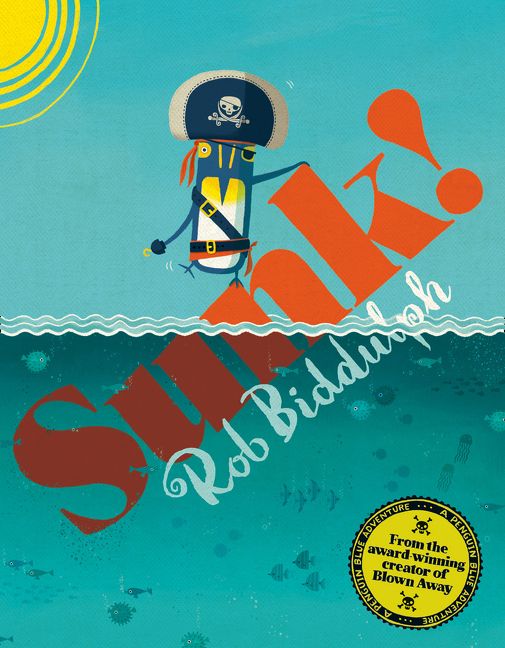
Image: harpercollins.ca
- After the first book’s resounding success, you must have been worried about how the second book would be received.
- Of course. I understood that two books about the same characters would inevitably be compared. The illustrations in Sunk! are quite different from those in Blown Away—they’re more complex, with greater detail. But the structure of the books and the rhyming are similar. I wanted children who enjoyed the first book to find the second one instantly familiar. It was interesting to mirror that structure, and I like the pirate theme, which helped manage the anxiety of expectations.
- Your first book Kevin ended up being your fifth to come out in Britain. How did that book come to be?
- My middle daughter Kitty had an imaginary friend named Cleverin. In the book, the boy blames his imaginary friend for all his mischief. That’s exactly what my daughter did when she was two. I asked her what her imaginary friend looked like and drew him based on her descriptions. That’s how we got Kevin (I simplified his name a bit). Life gives you wonderful stories, you just have to develop them a little further.
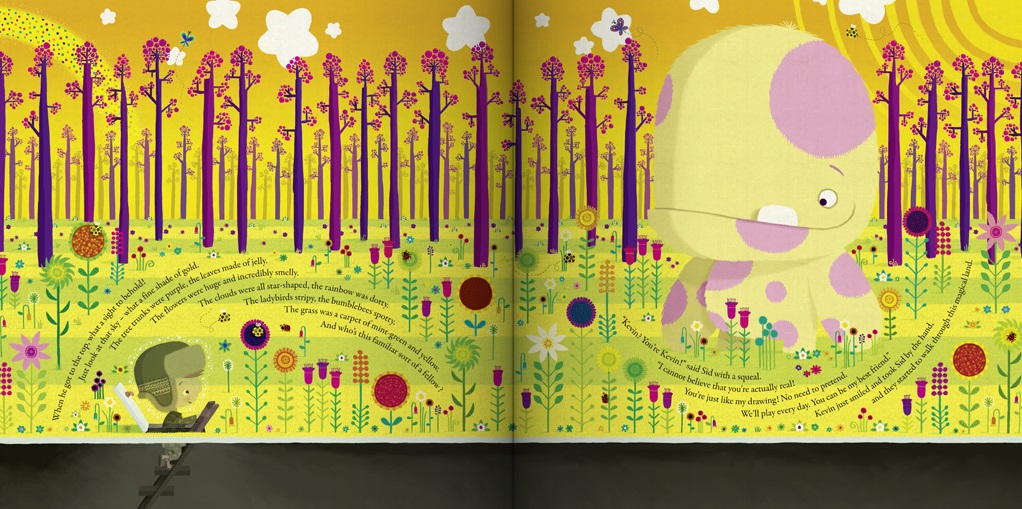
Image: robbiddulph.com
- Did you have imaginary friends of your own as a child?
- Well, I did give my stuffed bears different voices, came up with and drew characters, but no, I never had “real” imaginary friends like Kitty did. She even had imaginary parents! (Laughs)
- You have three daughters that you enjoy reading to before bed. Please tell us a bit more about reading in your family.
- Reading is an important ritual in our home. My wife is a journalist and writer and we have lots of books in the house. We’ve been reading to the girls at bedtime since they were born. That may be why they so love reading to this day—it’s a habit. My eldest daughter is 21 now and at university but we continued to read to her before bed until she was about fifteen. It’s vital to show kids that reading is first and foremost, for pleasure.
For me and my wife, it’s about the time we spend one-on-one with each of our daughters at the end of the day. We’re all busy with school, work, and clubs, so it’s so nice to read and talk about a book when we put the children to bed. A book can be the starting point for a conversation about almost anything. Our middle daughter is thirteen, and we’re still reading to her as well—she’s all for it. It’s become a family tradition.
- Were you read to as a child? What books did you like?
- Yes, my mom read to me before bed. I loved Richard Scarry’s books. I read them to my own children as well. His illustrations are very detailed and as a child I could copy them out for hours. I think they were very influential for me. With my own illustrations, I try to add details that you don’t see right away. When children like a book they ask to have it read to them again and again and I want them to discover something new each time. It’s like a reward for being attentive, a pleasant surprise. I also like my characters to travel from one book into the next.
- Like the dachshund from Odd Dog Out Most recent English edition: HarperColllins, 2017. ISBN 9780008184780. that shows up in Kevin.
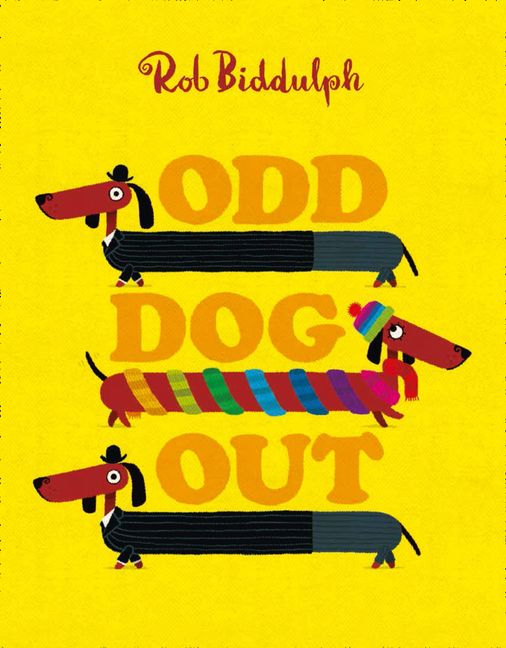
Image: harpercollins.com.au
- Exactly! In another of my books, there are toy penguins. Richard Scarry takes the same approach. My daughters and I used to play with his books, racing to find a little pig or other character on the page. It was very fun.
- What other books did you enjoy reading to your daughters when they were little?
- Judith Kerr’s The Tiger Who Came to Tea. It’s one of Britain’s best-selling children’s books. I’m actually personally acquainted with Judith Kerr. She’s 95, full of life, and has a new book coming out soon!
I also read the girls How the Grinch Stole Christmas! by Dr. Seuss. It’s my favorite children’s book in terms of its text. It’s written in rhyme—flawlessly, I think—and is very funny. I think with poetry that’s done well, humor is a natural by-product. I love to read children’s poetry aloud. It’s like a game, allowing the children to guess the ends of the lines. By the way, it was the Grinch that inspired me to write a story for children in rhyme.
The kids and I also read Oliver Jeffers’s books, which are very popular in Britain. We especially enjoyed The Incredible Book Eating Boy, about a boy who ate books and got smarter. Oliver Jeffers drew illustrations on the pages of used books, so the book is a real work of art in itself. That book really showed me the options an artist has when it comes to picture books.
That’s how it all happened: Dr. Seuss’s poems and Oliver Jeffers’s illustrations inspired me to make my own book.
- What comes first as you start work on a book—the words or the pictures?
- It all starts with the idea. Like a dachshund that’s not like everyone else. The notes app on my phone has thousands of ideas. Of course, most of them aren’t that great, but sometimes there’s something there.
Then I sketch things, draw the characters. In the case of Odd Dog Out, I first made the spread where you see all the different dachshunds. You see it at the end of the book now. As I was drawing it, I came up with the whole story.
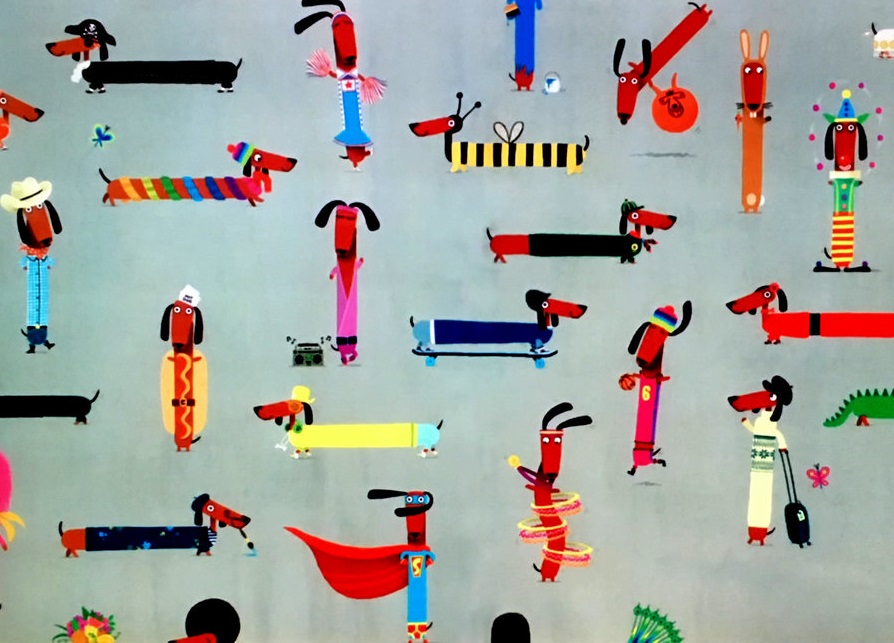
Image: robbiddulph.com
When the plot is ready, I start on the hardest part—putting it in rhyme. The text is very important to me. A story that reads in 5-10 minutes takes me six months or even a year to write. I want every word to be in its place and fit perfectly into the rhyme scheme.
The illustrations come to me a lot easier than the rhyme. I spent many years working as a designer and art director in media. Now that’s where people know how to write! I never considered myself a writer and, in a strange way, writing in poetry form, which I see as a sort of maths problem to solve, became a way for me to defend myself, gave me confidence. It seemed that if I wrote it in prose, everyone would know I’m not a real writer. But poetry in particular, when I can pull it off, brings me the greatest satisfaction with my work.
- When you come up with stories, do you think back to your own childhood experiences or observe your children, as with Kevin?
- I recently realized that most of my books are about getting a home or returning to one. I was a shy, rather introverted child that preferred to stay home. The house, family, close friends, a sense of belonging and security are really important to me and I think that comes through in my books. But I haven’t used any specific stories from my childhood yet.
- Did you ever feel you were an outsider, like the dachshund in Odd Dog Out?
- I can’t say I quite stood out in school, though I did very much want to be somehow special. I had friends, played on the school football team, and enjoyed drawing. I never felt like an outsider. I came up with Odd Dog Out when my youngest daughter came home from school and said that many children in her class had lunchboxes with Disney characters and she didn’t. I asked her, “Do you like your own lunchbox?” She said, “Yes, but it would be better if it were like the ones everyone else has.” That’s when I remembered several occasions when one of my friends would be embarrassed for being different from the group. And it’s so important to be happy with who you really are.
- Rob, what would you say makes for a good picture book?
- Making picture books is quite a challenge. I don’t think there’s one particular formula for success. What’s tricky, and it took me a while to understand this, is that a picture book should be appealing to both kids and adults. The adult should want to buy the book and the child should enjoy it, or the parent won’t buy the author’s next book. Finding that balance is like walking a tightrope. Some of the picture books that I find wonderful in terms of their pictures and text, my children have no interest in whatsoever. And it works the other way around, too. Sometimes they love books and I think to myself: “God, what is that?”
It seems that I stumbled upon that balance in Blown Away. I don’t know how it happened, but I got lucky—I found my own recognizable style, which readers enjoyed. I don’t want to stop there and I’m constantly developing my style and watching it change.
- You were chosen as the official illustrator for the 2019 and 2020 World Book Day. What does this mean to you?
- World Book Day is a charity event, which supports the idea of reading for pleasure and is directed at children of all ages. In Britain, the organizers choose about ten children’s books every year, which are then sold in bookstores and online stores for one pound. Every British schoolchild gets a voucher for one pound that he or she can spend on one of these books. When I visit schools in underprivileged areas of Britain, it turns out that many children don’t have any books at home at all. Either their families don’t have the money or they don’t think reading is all that important. It’s very sad. That’s why I think World Book Day is a wonderful initiative. It’s a week of book events and festivals across the country, children dress up as their favorite literary characters, and teachers help students prepare various book-related projects….
I’ve been working with the organizers for several years now, participating in book-related events organized in major cities. It’s a real show—there are more than two thousand children in the audience! As the official illustrator, I created the logo and design for World Book Day and came up with and illustrated ten bookmark-characters. Any such project that inspires kids to read is fantastic, and it’s a great honor for me to be a part of this event.
Interview by Darya Dotsuk
Photo by Darya Dotsuk and Vasilisa Solovieva

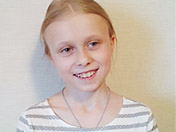
Anna Semerikova, a member of Papmambook’s teenage staff, met Rob Biddulph at the 20th Non/Fiction book fair and had the chance to ask him a few questions.
- Rob, could you tell me why you came up with square penguins for your book Blown Away? After all, penguins aren’t square in real life.
- I want children to able to draw their favorite characters. And the square is a very simple shape—look!
Rob takes a marker and draws a square that he quickly transforms into a penguin. His master class has begun! He then draws a very funny sausage dog, with a hot dog inside… just the kind of hot dog dogs dream of!
- If you want your character to have a smile up to their ears, draw his eyebrows higher than his eyes. Much higher! Like this!
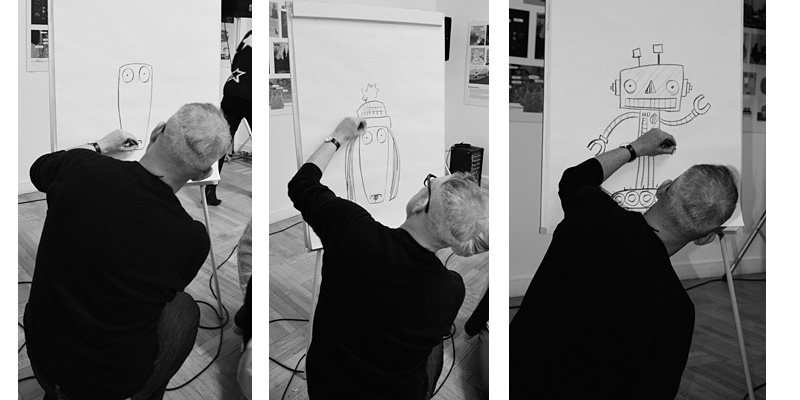
The kids draw and he encourages the youngsters with an approving nod, admiring their drawings.
- If you’d like to ask me anything, go ahead!
- You dedicated Blown Away to Ella. Who’s she?
- That’s my eldest daughter. I love writing books for my own kids.
- Your characters often go on trips around the world—Penguin Blue, the Odd Dog, and others. Did you want to be a sailor and travel the world when you were younger?
- Not at all! (Laughs) I dreamed of being a football player. I became an illustrator and author. It’s true that my characters wander a lot and gain experience along the way. But what really matters is that they come home. Home is very important. It’s a safe haven, where you come back to yourself and gather strength.
- In Odd Dog Out, the dachshund who’s the main character is a real non-conformist and she does everything differently, seeking out adventure. But Penguin Blue, who flew over the world with a kite, says: no, I’ll never fly again! I prefer being home. What draws you to create such different characters?
- I want my children and everyone who reads my stories to know that being yourself, being different is very important. As a child, I was very well-behaved, I didn’t like to stand out. Now I believe it’s important to be able to do both, find a balance, a middle ground—your place in the world. I want children to be able to do that.
Translated from the Russian by Alisa Cherkasova
Follow us on Facebook.
